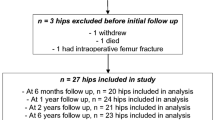Abstract
We have previously reported the short-term migration of cemented Hinek femoral components using radiostereometric analysis (RSA). We now report the mid-term migration. During the first 2 years after implantation the prosthesis subsided into varus and rotated internally. Between years 3 and 8 the prosthesis continued to rotate internally with the head moving posteriorly (0.07 mm/year, P=0.004). It also continued to fall into varus with the tip moving laterally (0.07 mm/year, P=0.04). The head (0.06 mm/year, P<0.0001), shoulder (0.04 mm/year, P=0.0001) and tip (0.04 mm/year, P=0.001) continued to migrate distally. There were two cases of failure due to aseptic loosening during the follow-up period. During the second year both of these had posterior head migration, which was abnormally rapid (>2 SD from the mean). We have demonstrated that a cemented implant has slow but significant levels of migration and rotation for at least 8 years after implantation. Our study confirms that implants with abnormally rapid posterior head migration during the second year are likely to fail.
Résumé
Nous avons récemment étudié la migration à court terme des composants cémentés Hinek en utilisant l’analyse radiostéréométrique (RSA). Nous atteignons maintenant un recul de 3 a 8 ans. Entre la 3ème et la 8ème année, il est évident que la prothèse continue une rotation interne avec la tête, elle même en mouvement postérieur (0.07 mm/an, P=0.004). La prothèse a continué de progresser en varus, le bout migrant latéralement (0.07 mm/an, P=0.07). La tête (0.06 mm/an, P<0.0001), l’épaule (0.04 mm/an, P=0.001) et le bout (0.04 mm/an, P=0.001) ont continué de migrer distallement. Il y a eu deux cas d’échec pendant la periode qui suivit, les deux présentant une migration anormalement élevée pendant la deuxième année. Dans les deux cas, une anomalie majeure était une rapide migration postérieure de la tête. Nous avons démontré que l’implant cimenté présente des niveaux de migration et rotation lents mais significatifs pendant au moins 8 ans aprés l’implantation. Nos études confirment que des implants qui ont une migration postérieure de la tête anormalement rapide pendant la deuxième annèe présentent un plus grand risque d’échec précoce.
Similar content being viewed by others
Author information
Authors and Affiliations
Additional information
Accepted: 17 May 1999
Rights and permissions
About this article
Cite this article
Alfaro-Adrian, J., Gill, H., Marks, B. et al. Mid-term migration of a cemented total hip replacement assessed by radiostereometric analysis. International Orthopaedics SICOT 23, 140–144 (1999). https://doi.org/10.1007/s002640050331
Issue Date:
DOI: https://doi.org/10.1007/s002640050331




